protection of the environment and human health PDF
VerifiedAdded on 2021/08/23
|8
|1923
|37
AI Summary
Contribute Materials
Your contribution can guide someone’s learning journey. Share your
documents today.
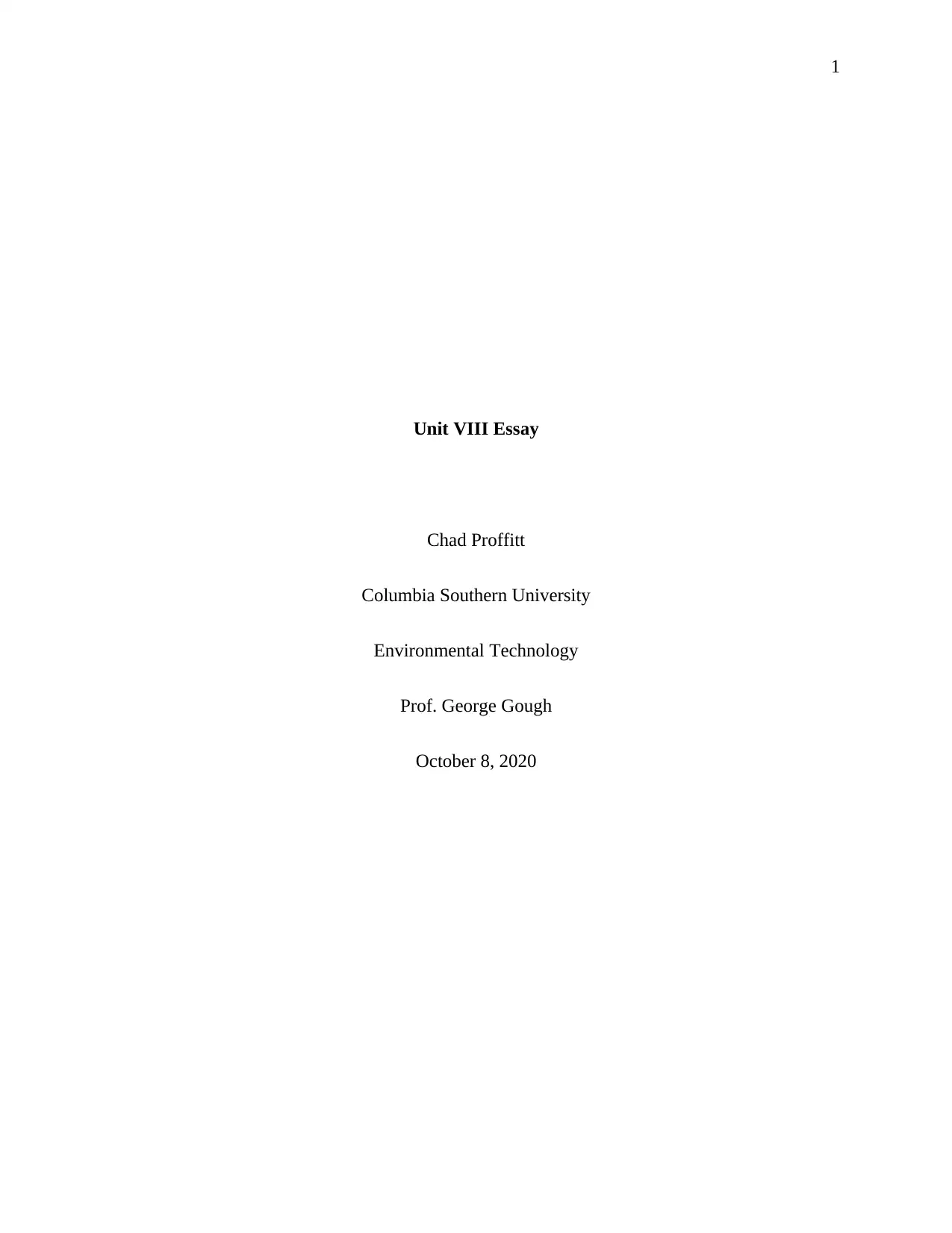
1
Unit VIII Essay
Chad Proffitt
Columbia Southern University
Environmental Technology
Prof. George Gough
October 8, 2020
Unit VIII Essay
Chad Proffitt
Columbia Southern University
Environmental Technology
Prof. George Gough
October 8, 2020
Secure Best Marks with AI Grader
Need help grading? Try our AI Grader for instant feedback on your assignments.
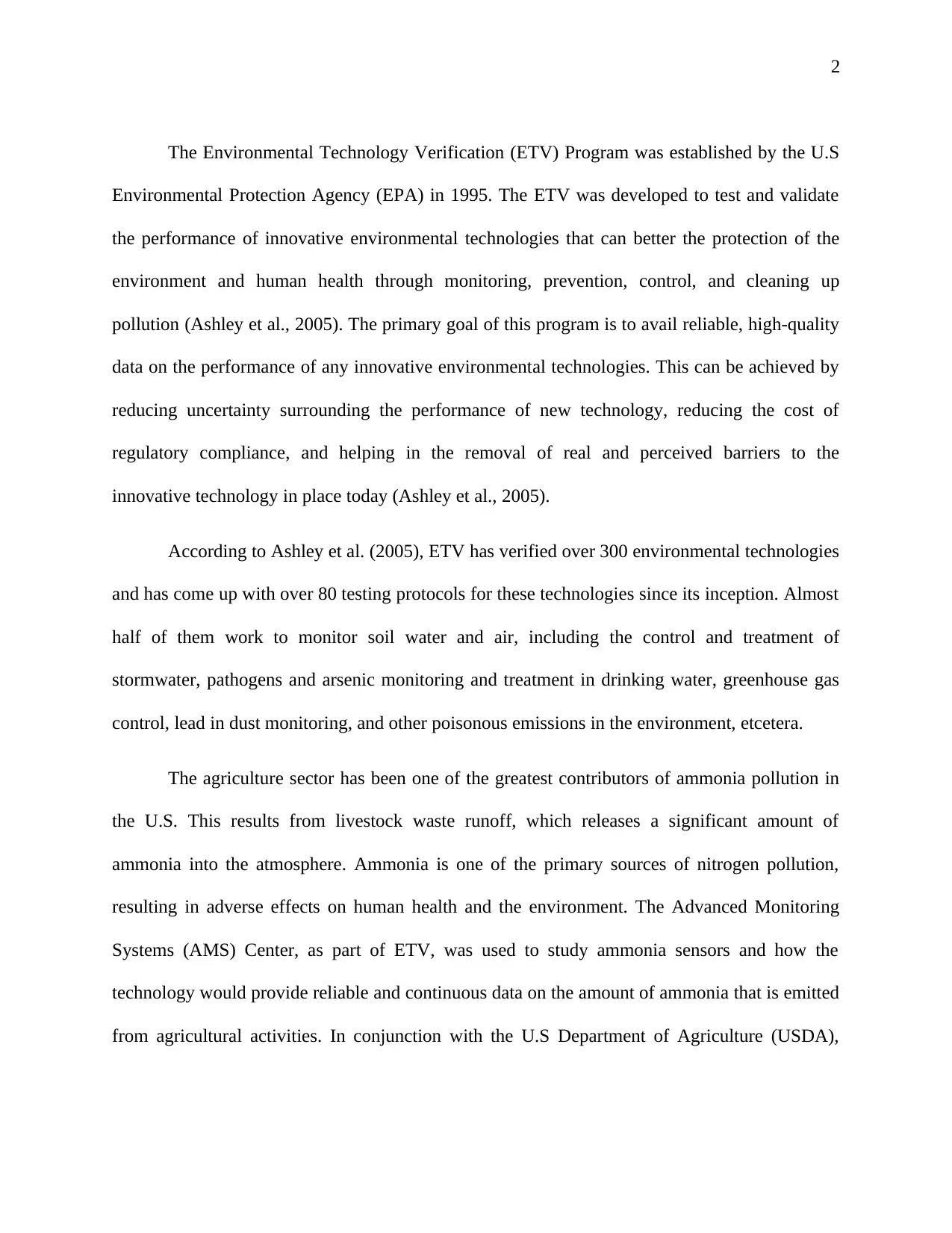
2
The Environmental Technology Verification (ETV) Program was established by the U.S
Environmental Protection Agency (EPA) in 1995. The ETV was developed to test and validate
the performance of innovative environmental technologies that can better the protection of the
environment and human health through monitoring, prevention, control, and cleaning up
pollution (Ashley et al., 2005). The primary goal of this program is to avail reliable, high-quality
data on the performance of any innovative environmental technologies. This can be achieved by
reducing uncertainty surrounding the performance of new technology, reducing the cost of
regulatory compliance, and helping in the removal of real and perceived barriers to the
innovative technology in place today (Ashley et al., 2005).
According to Ashley et al. (2005), ETV has verified over 300 environmental technologies
and has come up with over 80 testing protocols for these technologies since its inception. Almost
half of them work to monitor soil water and air, including the control and treatment of
stormwater, pathogens and arsenic monitoring and treatment in drinking water, greenhouse gas
control, lead in dust monitoring, and other poisonous emissions in the environment, etcetera.
The agriculture sector has been one of the greatest contributors of ammonia pollution in
the U.S. This results from livestock waste runoff, which releases a significant amount of
ammonia into the atmosphere. Ammonia is one of the primary sources of nitrogen pollution,
resulting in adverse effects on human health and the environment. The Advanced Monitoring
Systems (AMS) Center, as part of ETV, was used to study ammonia sensors and how the
technology would provide reliable and continuous data on the amount of ammonia that is emitted
from agricultural activities. In conjunction with the U.S Department of Agriculture (USDA),
The Environmental Technology Verification (ETV) Program was established by the U.S
Environmental Protection Agency (EPA) in 1995. The ETV was developed to test and validate
the performance of innovative environmental technologies that can better the protection of the
environment and human health through monitoring, prevention, control, and cleaning up
pollution (Ashley et al., 2005). The primary goal of this program is to avail reliable, high-quality
data on the performance of any innovative environmental technologies. This can be achieved by
reducing uncertainty surrounding the performance of new technology, reducing the cost of
regulatory compliance, and helping in the removal of real and perceived barriers to the
innovative technology in place today (Ashley et al., 2005).
According to Ashley et al. (2005), ETV has verified over 300 environmental technologies
and has come up with over 80 testing protocols for these technologies since its inception. Almost
half of them work to monitor soil water and air, including the control and treatment of
stormwater, pathogens and arsenic monitoring and treatment in drinking water, greenhouse gas
control, lead in dust monitoring, and other poisonous emissions in the environment, etcetera.
The agriculture sector has been one of the greatest contributors of ammonia pollution in
the U.S. This results from livestock waste runoff, which releases a significant amount of
ammonia into the atmosphere. Ammonia is one of the primary sources of nitrogen pollution,
resulting in adverse effects on human health and the environment. The Advanced Monitoring
Systems (AMS) Center, as part of ETV, was used to study ammonia sensors and how the
technology would provide reliable and continuous data on the amount of ammonia that is emitted
from agricultural activities. In conjunction with the U.S Department of Agriculture (USDA),
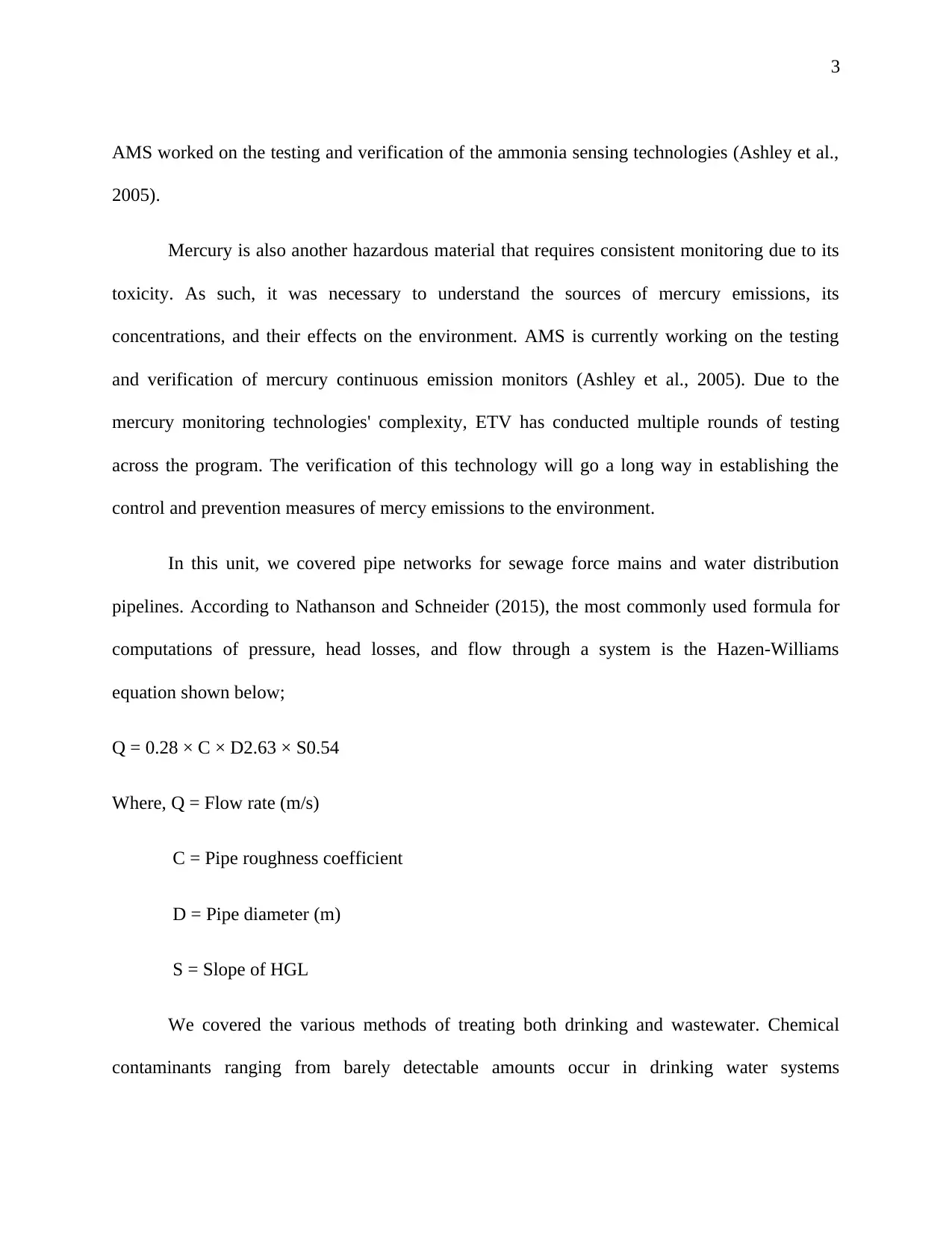
3
AMS worked on the testing and verification of the ammonia sensing technologies (Ashley et al.,
2005).
Mercury is also another hazardous material that requires consistent monitoring due to its
toxicity. As such, it was necessary to understand the sources of mercury emissions, its
concentrations, and their effects on the environment. AMS is currently working on the testing
and verification of mercury continuous emission monitors (Ashley et al., 2005). Due to the
mercury monitoring technologies' complexity, ETV has conducted multiple rounds of testing
across the program. The verification of this technology will go a long way in establishing the
control and prevention measures of mercy emissions to the environment.
In this unit, we covered pipe networks for sewage force mains and water distribution
pipelines. According to Nathanson and Schneider (2015), the most commonly used formula for
computations of pressure, head losses, and flow through a system is the Hazen-Williams
equation shown below;
Q = 0.28 × C × D2.63 × S0.54
Where, Q = Flow rate (m/s)
C = Pipe roughness coefficient
D = Pipe diameter (m)
S = Slope of HGL
We covered the various methods of treating both drinking and wastewater. Chemical
contaminants ranging from barely detectable amounts occur in drinking water systems
AMS worked on the testing and verification of the ammonia sensing technologies (Ashley et al.,
2005).
Mercury is also another hazardous material that requires consistent monitoring due to its
toxicity. As such, it was necessary to understand the sources of mercury emissions, its
concentrations, and their effects on the environment. AMS is currently working on the testing
and verification of mercury continuous emission monitors (Ashley et al., 2005). Due to the
mercury monitoring technologies' complexity, ETV has conducted multiple rounds of testing
across the program. The verification of this technology will go a long way in establishing the
control and prevention measures of mercy emissions to the environment.
In this unit, we covered pipe networks for sewage force mains and water distribution
pipelines. According to Nathanson and Schneider (2015), the most commonly used formula for
computations of pressure, head losses, and flow through a system is the Hazen-Williams
equation shown below;
Q = 0.28 × C × D2.63 × S0.54
Where, Q = Flow rate (m/s)
C = Pipe roughness coefficient
D = Pipe diameter (m)
S = Slope of HGL
We covered the various methods of treating both drinking and wastewater. Chemical
contaminants ranging from barely detectable amounts occur in drinking water systems
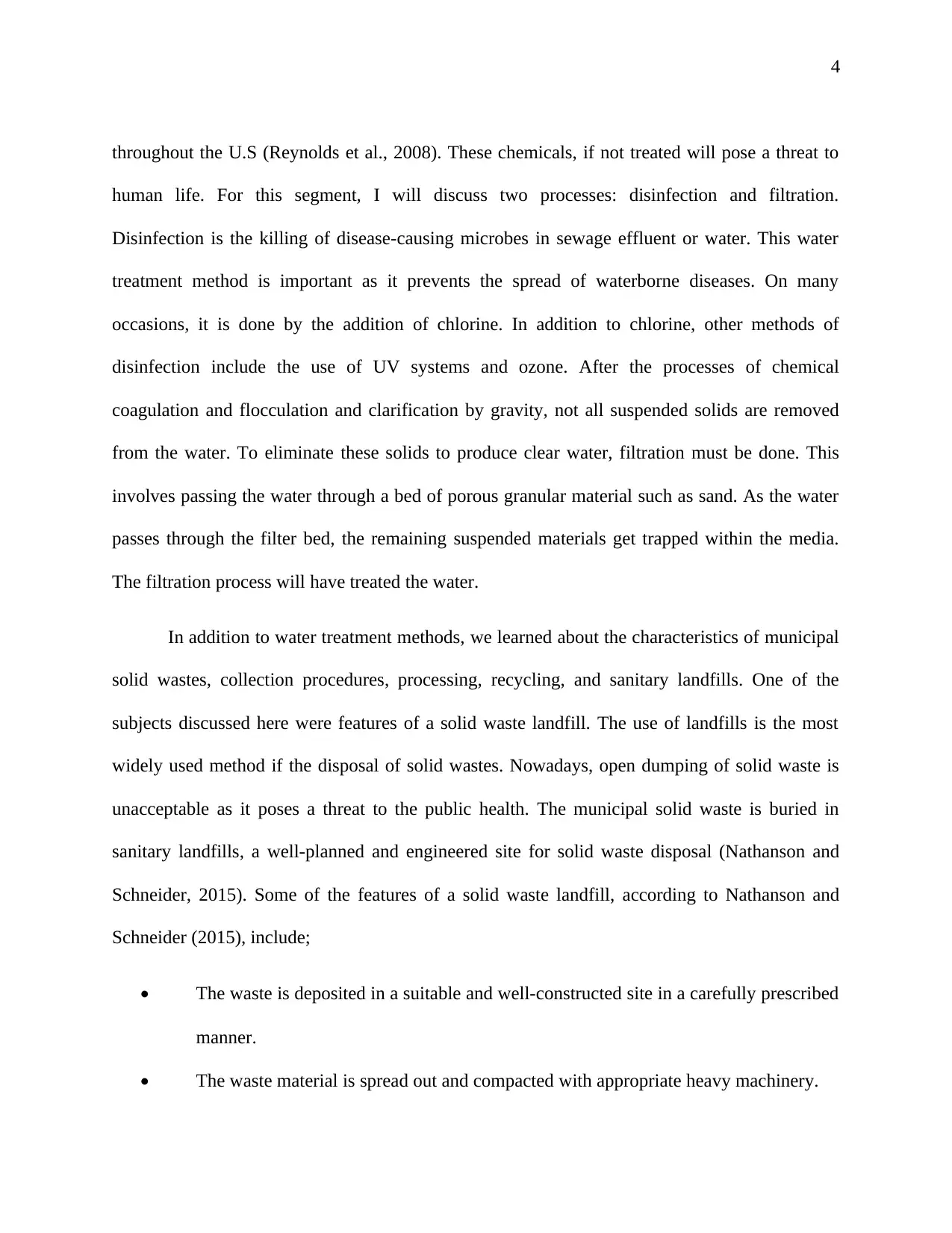
4
throughout the U.S (Reynolds et al., 2008). These chemicals, if not treated will pose a threat to
human life. For this segment, I will discuss two processes: disinfection and filtration.
Disinfection is the killing of disease-causing microbes in sewage effluent or water. This water
treatment method is important as it prevents the spread of waterborne diseases. On many
occasions, it is done by the addition of chlorine. In addition to chlorine, other methods of
disinfection include the use of UV systems and ozone. After the processes of chemical
coagulation and flocculation and clarification by gravity, not all suspended solids are removed
from the water. To eliminate these solids to produce clear water, filtration must be done. This
involves passing the water through a bed of porous granular material such as sand. As the water
passes through the filter bed, the remaining suspended materials get trapped within the media.
The filtration process will have treated the water.
In addition to water treatment methods, we learned about the characteristics of municipal
solid wastes, collection procedures, processing, recycling, and sanitary landfills. One of the
subjects discussed here were features of a solid waste landfill. The use of landfills is the most
widely used method if the disposal of solid wastes. Nowadays, open dumping of solid waste is
unacceptable as it poses a threat to the public health. The municipal solid waste is buried in
sanitary landfills, a well-planned and engineered site for solid waste disposal (Nathanson and
Schneider, 2015). Some of the features of a solid waste landfill, according to Nathanson and
Schneider (2015), include;
• The waste is deposited in a suitable and well-constructed site in a carefully prescribed
manner.
• The waste material is spread out and compacted with appropriate heavy machinery.
throughout the U.S (Reynolds et al., 2008). These chemicals, if not treated will pose a threat to
human life. For this segment, I will discuss two processes: disinfection and filtration.
Disinfection is the killing of disease-causing microbes in sewage effluent or water. This water
treatment method is important as it prevents the spread of waterborne diseases. On many
occasions, it is done by the addition of chlorine. In addition to chlorine, other methods of
disinfection include the use of UV systems and ozone. After the processes of chemical
coagulation and flocculation and clarification by gravity, not all suspended solids are removed
from the water. To eliminate these solids to produce clear water, filtration must be done. This
involves passing the water through a bed of porous granular material such as sand. As the water
passes through the filter bed, the remaining suspended materials get trapped within the media.
The filtration process will have treated the water.
In addition to water treatment methods, we learned about the characteristics of municipal
solid wastes, collection procedures, processing, recycling, and sanitary landfills. One of the
subjects discussed here were features of a solid waste landfill. The use of landfills is the most
widely used method if the disposal of solid wastes. Nowadays, open dumping of solid waste is
unacceptable as it poses a threat to the public health. The municipal solid waste is buried in
sanitary landfills, a well-planned and engineered site for solid waste disposal (Nathanson and
Schneider, 2015). Some of the features of a solid waste landfill, according to Nathanson and
Schneider (2015), include;
• The waste is deposited in a suitable and well-constructed site in a carefully prescribed
manner.
• The waste material is spread out and compacted with appropriate heavy machinery.
Secure Best Marks with AI Grader
Need help grading? Try our AI Grader for instant feedback on your assignments.
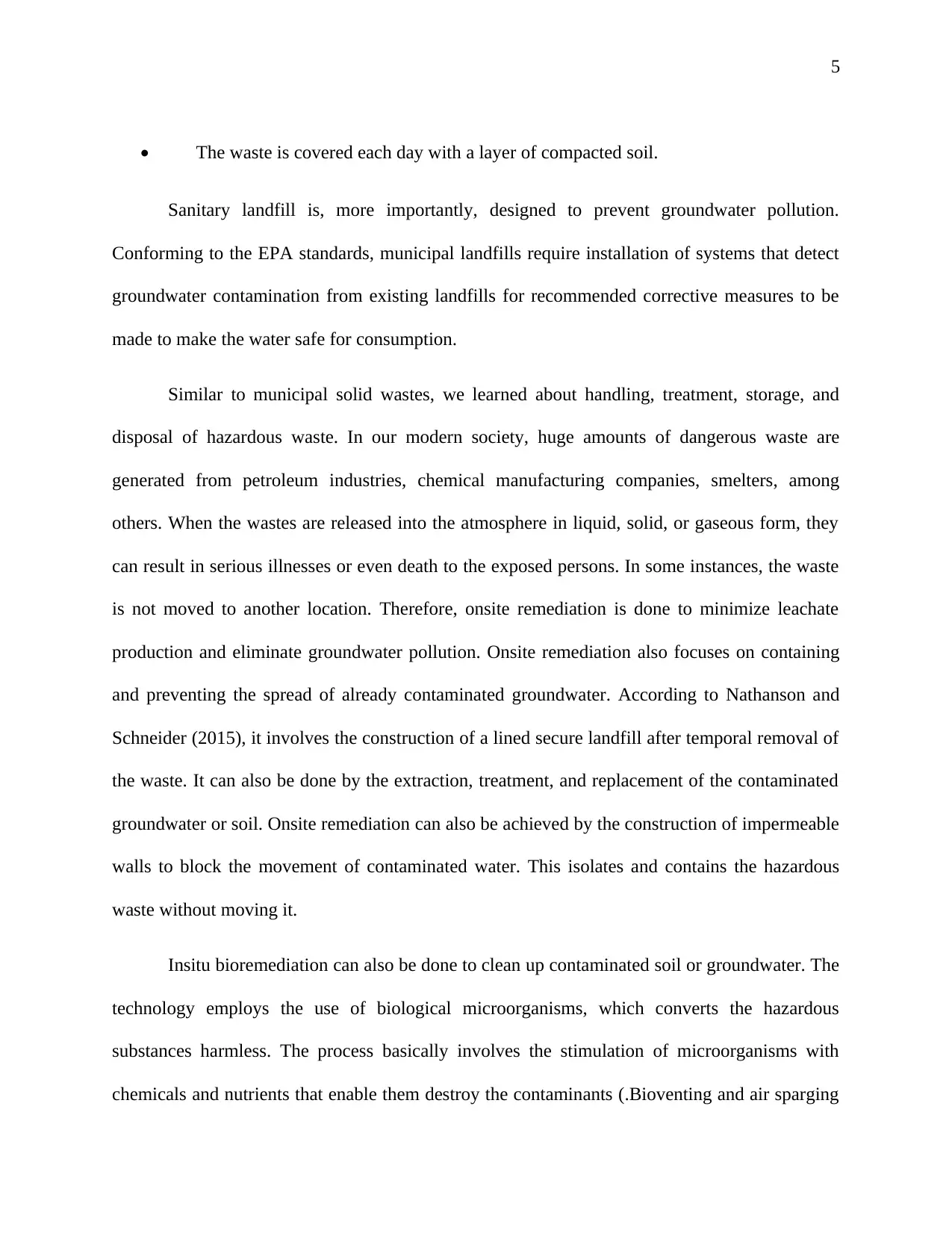
5
• The waste is covered each day with a layer of compacted soil.
Sanitary landfill is, more importantly, designed to prevent groundwater pollution.
Conforming to the EPA standards, municipal landfills require installation of systems that detect
groundwater contamination from existing landfills for recommended corrective measures to be
made to make the water safe for consumption.
Similar to municipal solid wastes, we learned about handling, treatment, storage, and
disposal of hazardous waste. In our modern society, huge amounts of dangerous waste are
generated from petroleum industries, chemical manufacturing companies, smelters, among
others. When the wastes are released into the atmosphere in liquid, solid, or gaseous form, they
can result in serious illnesses or even death to the exposed persons. In some instances, the waste
is not moved to another location. Therefore, onsite remediation is done to minimize leachate
production and eliminate groundwater pollution. Onsite remediation also focuses on containing
and preventing the spread of already contaminated groundwater. According to Nathanson and
Schneider (2015), it involves the construction of a lined secure landfill after temporal removal of
the waste. It can also be done by the extraction, treatment, and replacement of the contaminated
groundwater or soil. Onsite remediation can also be achieved by the construction of impermeable
walls to block the movement of contaminated water. This isolates and contains the hazardous
waste without moving it.
Insitu bioremediation can also be done to clean up contaminated soil or groundwater. The
technology employs the use of biological microorganisms, which converts the hazardous
substances harmless. The process basically involves the stimulation of microorganisms with
chemicals and nutrients that enable them destroy the contaminants (.Bioventing and air sparging
• The waste is covered each day with a layer of compacted soil.
Sanitary landfill is, more importantly, designed to prevent groundwater pollution.
Conforming to the EPA standards, municipal landfills require installation of systems that detect
groundwater contamination from existing landfills for recommended corrective measures to be
made to make the water safe for consumption.
Similar to municipal solid wastes, we learned about handling, treatment, storage, and
disposal of hazardous waste. In our modern society, huge amounts of dangerous waste are
generated from petroleum industries, chemical manufacturing companies, smelters, among
others. When the wastes are released into the atmosphere in liquid, solid, or gaseous form, they
can result in serious illnesses or even death to the exposed persons. In some instances, the waste
is not moved to another location. Therefore, onsite remediation is done to minimize leachate
production and eliminate groundwater pollution. Onsite remediation also focuses on containing
and preventing the spread of already contaminated groundwater. According to Nathanson and
Schneider (2015), it involves the construction of a lined secure landfill after temporal removal of
the waste. It can also be done by the extraction, treatment, and replacement of the contaminated
groundwater or soil. Onsite remediation can also be achieved by the construction of impermeable
walls to block the movement of contaminated water. This isolates and contains the hazardous
waste without moving it.
Insitu bioremediation can also be done to clean up contaminated soil or groundwater. The
technology employs the use of biological microorganisms, which converts the hazardous
substances harmless. The process basically involves the stimulation of microorganisms with
chemicals and nutrients that enable them destroy the contaminants (.Bioventing and air sparging
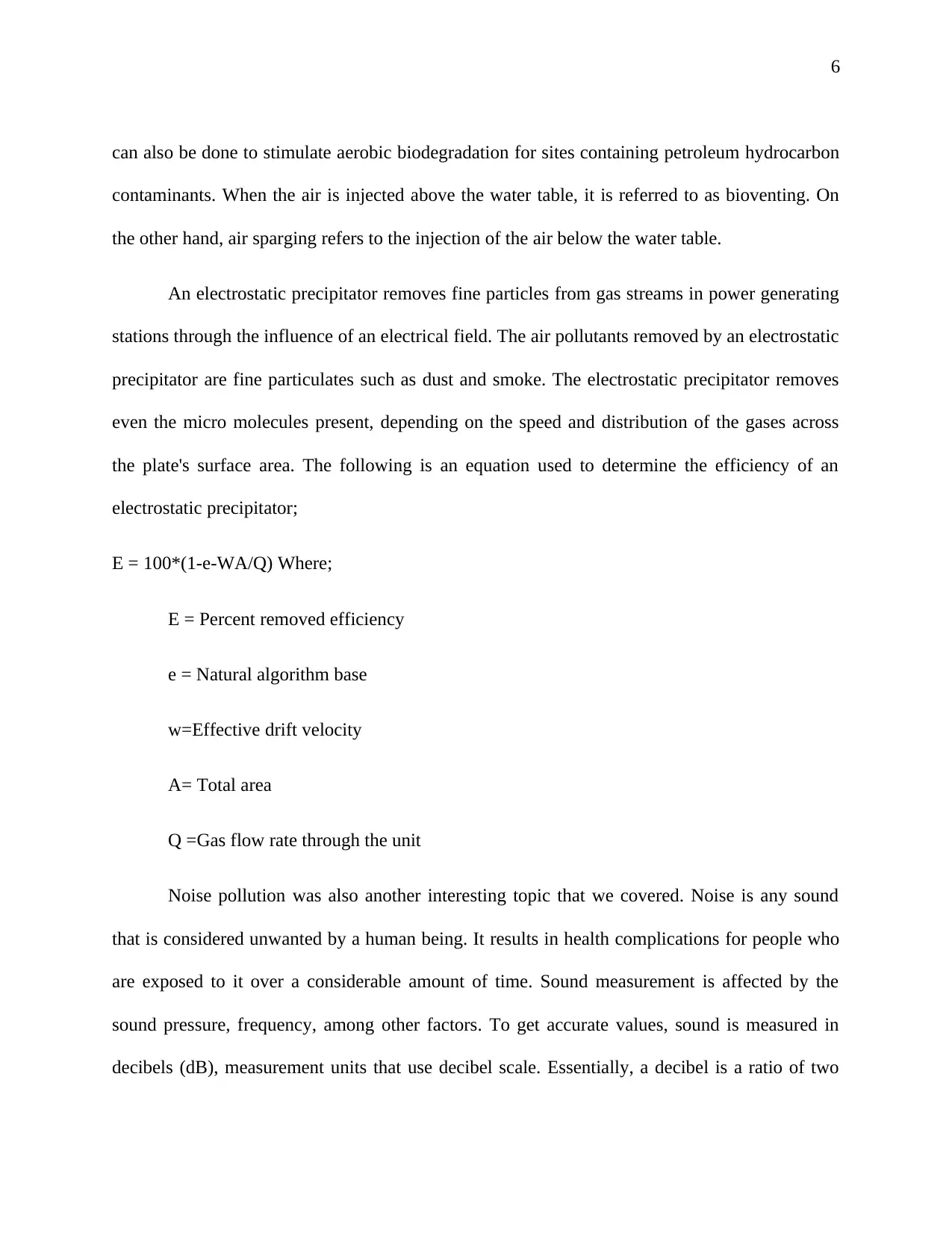
6
can also be done to stimulate aerobic biodegradation for sites containing petroleum hydrocarbon
contaminants. When the air is injected above the water table, it is referred to as bioventing. On
the other hand, air sparging refers to the injection of the air below the water table.
An electrostatic precipitator removes fine particles from gas streams in power generating
stations through the influence of an electrical field. The air pollutants removed by an electrostatic
precipitator are fine particulates such as dust and smoke. The electrostatic precipitator removes
even the micro molecules present, depending on the speed and distribution of the gases across
the plate's surface area. The following is an equation used to determine the efficiency of an
electrostatic precipitator;
E = 100*(1-e-WA/Q) Where;
E = Percent removed efficiency
e = Natural algorithm base
w=Effective drift velocity
A= Total area
Q =Gas flow rate through the unit
Noise pollution was also another interesting topic that we covered. Noise is any sound
that is considered unwanted by a human being. It results in health complications for people who
are exposed to it over a considerable amount of time. Sound measurement is affected by the
sound pressure, frequency, among other factors. To get accurate values, sound is measured in
decibels (dB), measurement units that use decibel scale. Essentially, a decibel is a ratio of two
can also be done to stimulate aerobic biodegradation for sites containing petroleum hydrocarbon
contaminants. When the air is injected above the water table, it is referred to as bioventing. On
the other hand, air sparging refers to the injection of the air below the water table.
An electrostatic precipitator removes fine particles from gas streams in power generating
stations through the influence of an electrical field. The air pollutants removed by an electrostatic
precipitator are fine particulates such as dust and smoke. The electrostatic precipitator removes
even the micro molecules present, depending on the speed and distribution of the gases across
the plate's surface area. The following is an equation used to determine the efficiency of an
electrostatic precipitator;
E = 100*(1-e-WA/Q) Where;
E = Percent removed efficiency
e = Natural algorithm base
w=Effective drift velocity
A= Total area
Q =Gas flow rate through the unit
Noise pollution was also another interesting topic that we covered. Noise is any sound
that is considered unwanted by a human being. It results in health complications for people who
are exposed to it over a considerable amount of time. Sound measurement is affected by the
sound pressure, frequency, among other factors. To get accurate values, sound is measured in
decibels (dB), measurement units that use decibel scale. Essentially, a decibel is a ratio of two
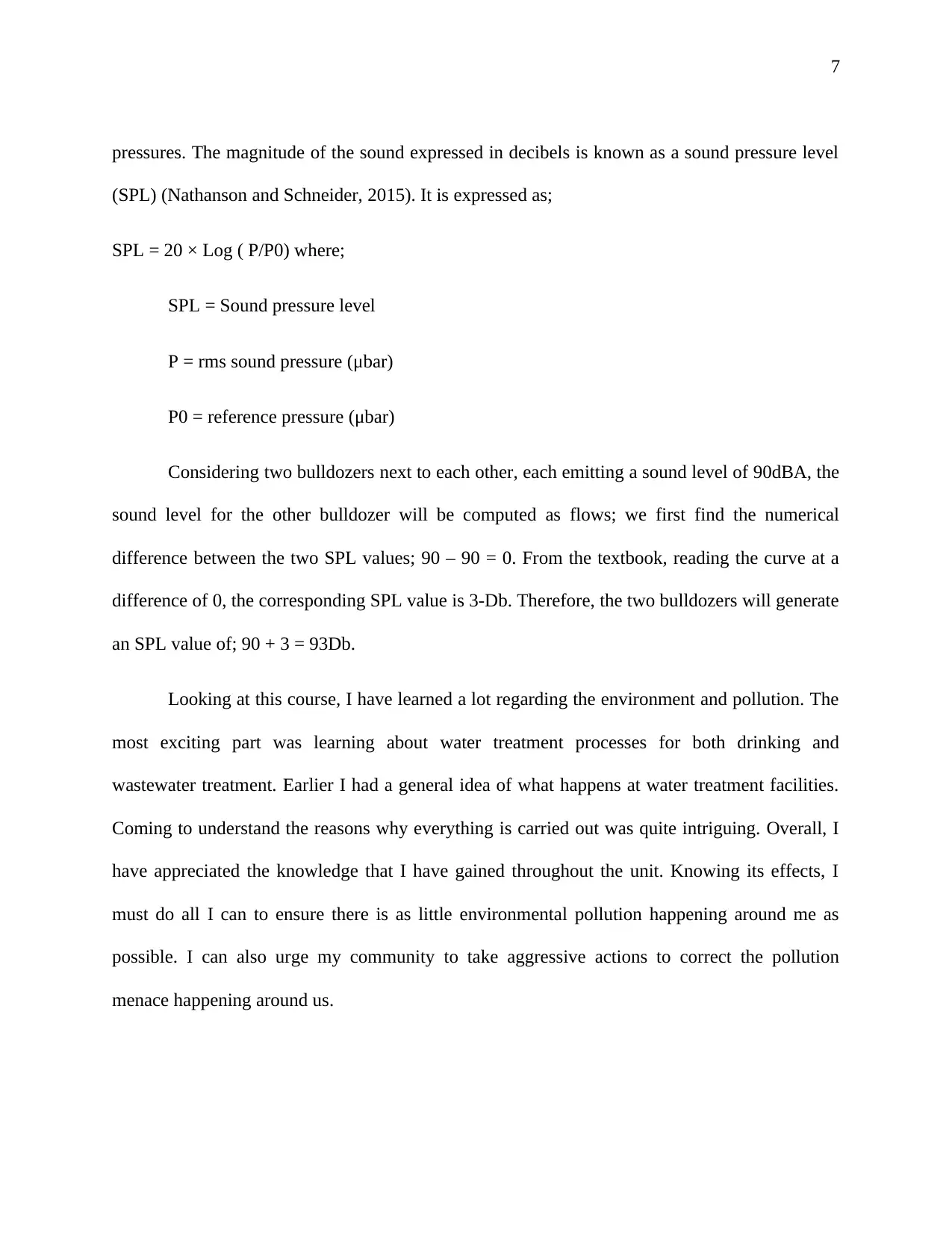
7
pressures. The magnitude of the sound expressed in decibels is known as a sound pressure level
(SPL) (Nathanson and Schneider, 2015). It is expressed as;
SPL = 20 × Log ( P/P0) where;
SPL = Sound pressure level
P = rms sound pressure (μbar)
P0 = reference pressure (μbar)
Considering two bulldozers next to each other, each emitting a sound level of 90dBA, the
sound level for the other bulldozer will be computed as flows; we first find the numerical
difference between the two SPL values; 90 – 90 = 0. From the textbook, reading the curve at a
difference of 0, the corresponding SPL value is 3-Db. Therefore, the two bulldozers will generate
an SPL value of; 90 + 3 = 93Db.
Looking at this course, I have learned a lot regarding the environment and pollution. The
most exciting part was learning about water treatment processes for both drinking and
wastewater treatment. Earlier I had a general idea of what happens at water treatment facilities.
Coming to understand the reasons why everything is carried out was quite intriguing. Overall, I
have appreciated the knowledge that I have gained throughout the unit. Knowing its effects, I
must do all I can to ensure there is as little environmental pollution happening around me as
possible. I can also urge my community to take aggressive actions to correct the pollution
menace happening around us.
pressures. The magnitude of the sound expressed in decibels is known as a sound pressure level
(SPL) (Nathanson and Schneider, 2015). It is expressed as;
SPL = 20 × Log ( P/P0) where;
SPL = Sound pressure level
P = rms sound pressure (μbar)
P0 = reference pressure (μbar)
Considering two bulldozers next to each other, each emitting a sound level of 90dBA, the
sound level for the other bulldozer will be computed as flows; we first find the numerical
difference between the two SPL values; 90 – 90 = 0. From the textbook, reading the curve at a
difference of 0, the corresponding SPL value is 3-Db. Therefore, the two bulldozers will generate
an SPL value of; 90 + 3 = 93Db.
Looking at this course, I have learned a lot regarding the environment and pollution. The
most exciting part was learning about water treatment processes for both drinking and
wastewater treatment. Earlier I had a general idea of what happens at water treatment facilities.
Coming to understand the reasons why everything is carried out was quite intriguing. Overall, I
have appreciated the knowledge that I have gained throughout the unit. Knowing its effects, I
must do all I can to ensure there is as little environmental pollution happening around me as
possible. I can also urge my community to take aggressive actions to correct the pollution
menace happening around us.
Paraphrase This Document
Need a fresh take? Get an instant paraphrase of this document with our AI Paraphraser
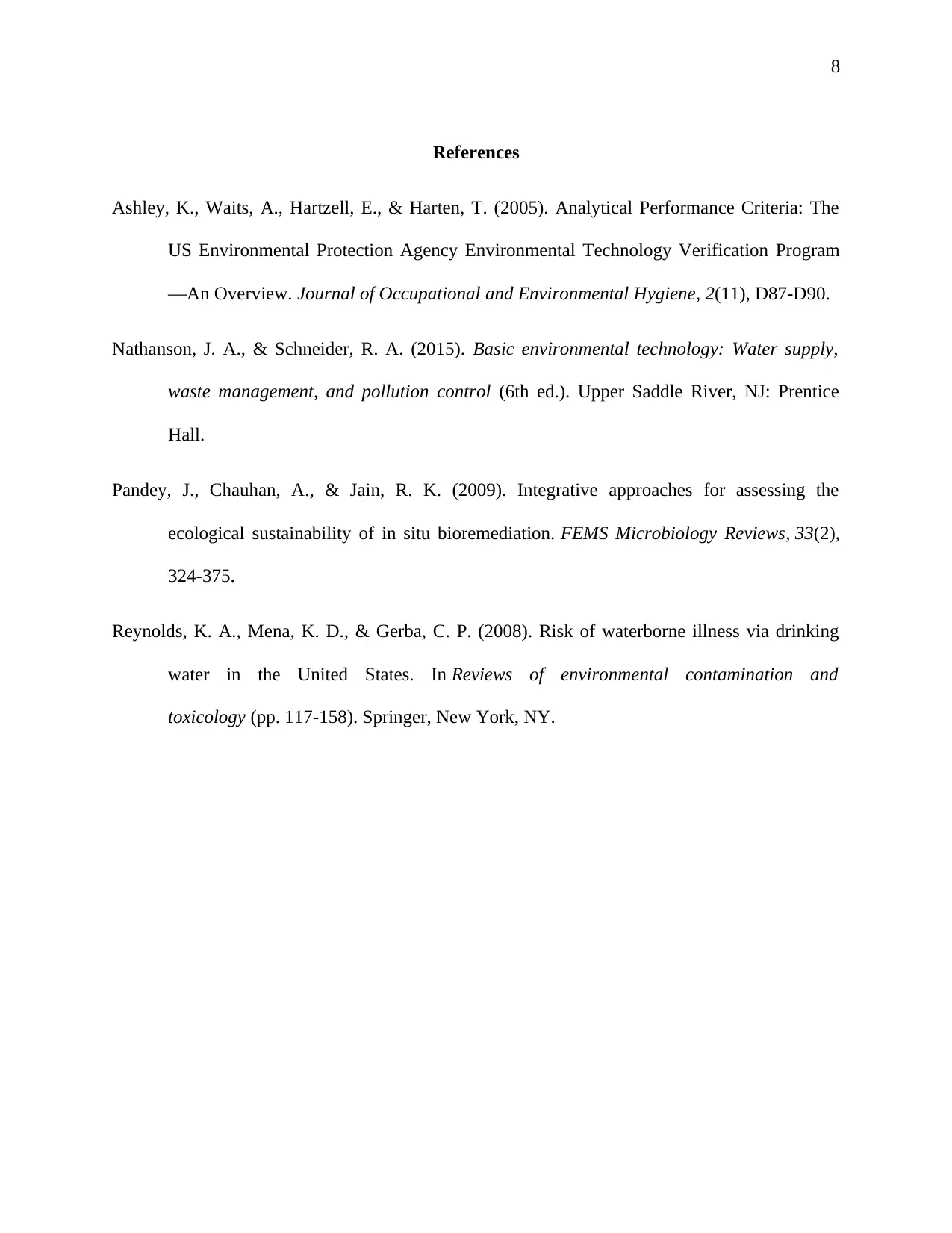
8
References
Ashley, K., Waits, A., Hartzell, E., & Harten, T. (2005). Analytical Performance Criteria: The
US Environmental Protection Agency Environmental Technology Verification Program
—An Overview. Journal of Occupational and Environmental Hygiene, 2(11), D87-D90.
Nathanson, J. A., & Schneider, R. A. (2015). Basic environmental technology: Water supply,
waste management, and pollution control (6th ed.). Upper Saddle River, NJ: Prentice
Hall.
Pandey, J., Chauhan, A., & Jain, R. K. (2009). Integrative approaches for assessing the
ecological sustainability of in situ bioremediation. FEMS Microbiology Reviews, 33(2),
324-375.
Reynolds, K. A., Mena, K. D., & Gerba, C. P. (2008). Risk of waterborne illness via drinking
water in the United States. In Reviews of environmental contamination and
toxicology (pp. 117-158). Springer, New York, NY.
References
Ashley, K., Waits, A., Hartzell, E., & Harten, T. (2005). Analytical Performance Criteria: The
US Environmental Protection Agency Environmental Technology Verification Program
—An Overview. Journal of Occupational and Environmental Hygiene, 2(11), D87-D90.
Nathanson, J. A., & Schneider, R. A. (2015). Basic environmental technology: Water supply,
waste management, and pollution control (6th ed.). Upper Saddle River, NJ: Prentice
Hall.
Pandey, J., Chauhan, A., & Jain, R. K. (2009). Integrative approaches for assessing the
ecological sustainability of in situ bioremediation. FEMS Microbiology Reviews, 33(2),
324-375.
Reynolds, K. A., Mena, K. D., & Gerba, C. P. (2008). Risk of waterborne illness via drinking
water in the United States. In Reviews of environmental contamination and
toxicology (pp. 117-158). Springer, New York, NY.
1 out of 8
Your All-in-One AI-Powered Toolkit for Academic Success.
+13062052269
info@desklib.com
Available 24*7 on WhatsApp / Email
![[object Object]](/_next/static/media/star-bottom.7253800d.svg)
Unlock your academic potential
© 2024 | Zucol Services PVT LTD | All rights reserved.

